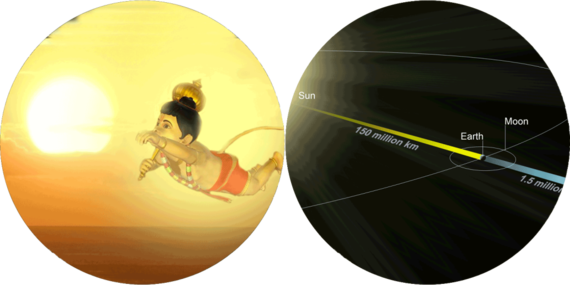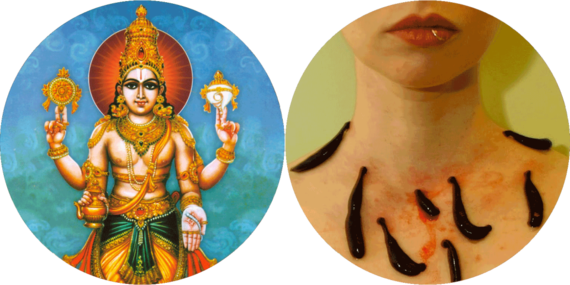This series is about taking story-telling beyond story-telling and letting your children connect the dots between stories and science. Part 1 and Part 2 of this series carried some great examples. Here are some more...
11. Distance of the Sun from the Earth:
Mythological Reference: According to Indian legend, Hanuman (The monkey god) mistook the setting sun to be an inviting fruit and flew all the way to the sun, only to be disappointed. The Hanuman Chalisa, a famous story-chant, also mentions this event and includes a mathematical reference.
The lines "Jug Sahasra Yojan Par Bhanu" reveal the distance he travelled to the Sun.
1 Jug = 12,000 years; Sahasra = 1,000 years; yojan= eight miles, which makes its 12000*1000*8 ~ 9,60,00,000 miles which is approximately 15,36,00,000 km.
Today's Science: The distance between the Sun and the Earth is reported as approximately 150,000,000 Km.
12. Leeches used in treatment:
Mythological Reference: Indian legend has it that when the great ccean was churned, a broad-chested man appeared with leeches in one hand and herbs in the other. He was called Dhnvanthari, the father of medicine, especially Ayurveda. This form of the 'first doctor' is worshipped in several famous temples of South India to this day.
Today's Science: Leeches are increasing being viewed as a radical tool for treatment; classified as Live Medical Devices. In 2004, the FDA cleared the use of Leech Therapy for medical purposes. (Reference: Pride of India, Samskrita Bharathi)
13. Surrogate Motherhood:
Mythological reference: The Mahabharata mentions that Balarama's biological mother, Devaki, transferred her womb to another woman, Rohini, to safeguard the child from her wicked brother, Kamsa.
Today's science: Gestational Surrogacy is a widely accepted alternative to natural conception today.
14. Atomic Warfare:
Mythological reference: The Mahabharata's great final war was akin to an Atomic war. The weapon of Brahma, called 'Brahmastra,' was known to be incredibly potent -- which could produce explosions that were brighter than a 'thousand suns.' After the war, there are references to people losing hair and nails, suggesting that weapons of mass destruction were indeed used in the war.
Today's science: Dr. Oppenheimer, the creator of the atomic bomb refers to the Mahabharata and the Bhagavad Gita as the inspiration behind his invention. Traces of Radioactive material and enormous destruction were excavated. When Dr. Oppenheimer was questioned by a student if the bomb detonated at Alamogordo was the first, he replied, "In Modern Times, of course!"
15. Sex Change:
Mythological Reference: Indian Legend has it that Vishnu, the Protector among the Trinity, took the female form of Mohini and Shiva (The destroyer) fell in love with her. Their union gave birth to a son, who later killed another demon.
Today's Science: Today we hear about 'miracle stories' of men giving birth to children after sex change surgeries and hormone therapy. This is still a long way to go from the story, where a man completely transforms into a woman and then gives birth. We are still at the stage where women can change their sex and yet keep their female reproductive organs to successfully bear children.
The Relevance
There is perennial debate on whether these stories were pure figments of imagination or if there is evidence of technical know-how in these stories. This debate is something we would rely on our archeologists and scientists to answer. (Some of the references above suggest sound technical knowledge). However, that is another matter (perhaps fodder for another post).
What matters is the potential of these stories to fire up sparks all over their little heads. What matters is the potential of all cultures and mythological contexts to make similar connections.
The next time you start with, "Once upon a time, long long ago... don't stop with that. Connect the dots with them all the way to their todays and tomorrows. And who knows? That little private horse could just become a reality by the time I become a grandparent!
After all, didn't Einstein say, "If you want your children to be intelligent, read them fairy tales. If you want them to be more intelligent, read them more fairy tales."
To see more fabulous examples connecting stories and science, look up Part 1 and Part 2 of this series.
This article first appeared on www.kidskintha.com
Were you bowled over by something your child just said? Let us know at www.kidskintha.com and we will help you cherish it forever!

